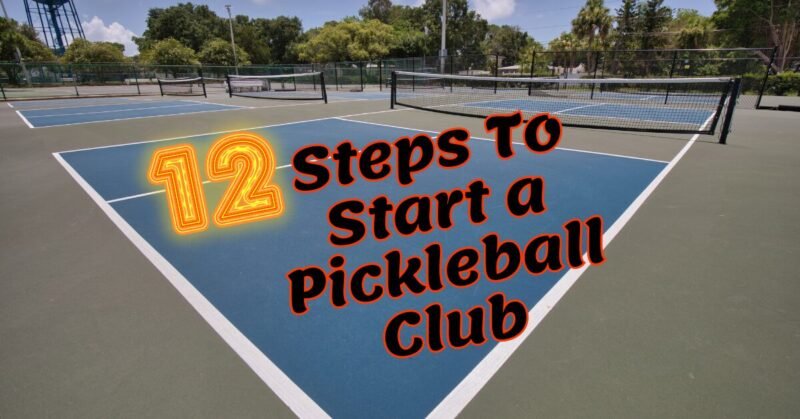Starting and running a successful pickleball club can be a rewarding journey, bringing people together through the love of the game. Whether you’re a seasoned player or new to the sport, creating a space where enthusiasts can gather, learn, and compete is a fantastic way to foster community and promote physical activity.
In this guide, we’ll walk you through the essential steps to start a pickleball club, ensuring it’s not only successful but also a vibrant hub for players of all levels. Let’s dive into how you can make your pickleball social club the go-to spot for fun, friendship, and fitness.
12 Steps to Start and Run a Successful Pickleball Club
Starting a pickleball club is an exciting venture that requires careful planning and execution. Many people might think pickleball sucks or pickleball should be banned but they do not know the social aspects of pickleball, this game allows all ages of people and introverts to engage in social pickleball clubs and also health benefits. Here’s how you can build a pickleball social club and successfully run this club in 12 steps:
1. Establish Clear Goals and Objectives for Your Club
Before diving into the logistics of setting up your pickleball club, it’s crucial to define what success looks like for you. Are you aiming to create a competitive environment, a social gathering space, or perhaps a blend of both? Setting clear, achievable goals will guide your decisions down the line, from the size of the club to the type of events you organize.
Consider factors like membership growth, community engagement, and the level of play you wish to foster. Having a clear vision will not only help in making strategic decisions but also in communicating your club’s purpose to potential members.
2. Choose a Suitable Location for Your Pickleball Club
The right location is key to the success of your club. Look for a venue that is accessible, safe, and has the necessary facilities for pickleball play. This could be a local community center, a park with existing courts, or even a space that can be converted into courts with some modifications.
Consider the number of courts you’ll need based on your membership goals and ensure there’s enough space for players to comfortably gather and store their equipment. Accessibility is crucial, so make sure the location is easy to get to by public transport or has ample parking for those driving.
3. Secure Necessary Permits and Insurance
Once you’ve found the perfect spot, the next step is to ensure you’re operating within legal boundaries. This means securing any necessary permits required to use the space for sporting activities. Check with your local government or park services to understand the requirements, which can vary widely depending on your location.
Additionally, obtaining insurance for your club is essential to protect yourself and your members from liability in case of accidents or injuries. Look into general liability insurance and consider additional coverage depending on your specific needs. This step is crucial for the safety and longevity of your club.
4. Gather Equipment and Materials
For your pickleball club to function smoothly, having the right equipment and materials is essential. Start with the basics: pickleball paddles, balls, and portable net systems if your courts aren’t already equipped with permanent nets.
Consider the level of play and the number of members to determine the quantity of equipment needed. Additionally, think about investing in a storage solution to keep your gear secure and in good condition. Don’t forget about maintenance tools for court upkeep and first aid kits for safety. Offering equipment rental or sales can also be a great way to generate additional revenue for the club.
5. Create Membership Guidelines and Fees
Clear membership guidelines are crucial for managing expectations and ensuring a smooth operation. Decide on the types of memberships you’ll offer (e.g., individual, family, student) and what benefits each tier includes, such as access to courts, equipment, and special events.
Set your membership fees based on the costs of running the club, the value provided to members, and competitive pricing in your area. Be transparent about how fees are used, whether for maintenance, equipment purchases, or club events. This transparency builds trust and value in your club membership.
6. Develop a Club Constitution and Bylaws
A constitution and bylaws are the backbone of your club’s structure and governance. They outline the club’s purpose, membership requirements, governance structure, meeting protocols, and procedures for making decisions and resolving disputes.
Start by defining your club’s mission and objectives, then establish the roles and responsibilities of officers and committees. Include election procedures, meeting schedules, and amendment processes. Having a solid set of bylaws ensures that your club operates smoothly and provides a clear framework for managing the club’s affairs.
7. Promote Your Pickleball Club
Effective promotion is key to attracting new members and establishing your club in the local community. Start by creating a website and social media profiles to share news, events, and photos. These platforms are great for engaging with members and reaching potential new ones.
Consider leveraging local community boards, sports centers, and schools to spread the word. Hosting open house events or free play days can also attract interest by giving people a taste of what your club offers. Don’t underestimate the power of word-of-mouth; encourage current members to bring friends and share their experiences.
8. Organize Regular Play Sessions, Events, and Tournaments
Organize leagues and encourage people to join pickleball leagues, Regular play sessions are the heart of your club, providing members with consistent opportunities to play and improve their skills. Schedule sessions for different skill levels to ensure everyone has a place to participate comfortably. Beyond regular play, organize social events and tournaments to add variety and excitement.
Tournaments can range from friendly, club-level competitions to larger events that attract players from surrounding areas. Social events, such as picnics or charity fundraisers, can help members bond outside of play, strengthening the community feel.
9. Foster a Sense of Community Within Your Club
A strong sense of community is what makes a club more than just a place to play sports; it becomes a supportive network of friends. Encourage members to get to know each other through buddy systems or mentorship programs for new players. Create a welcoming environment by promoting sportsmanship, respect, and inclusivity.
Recognize and celebrate member achievements, birthdays, and milestones, both on and off the court. Consider forming committees or interest groups within the club to involve members in decision-making and event planning, further enhancing their sense of belonging and investment in the club’s success.
10. Training and Development
Offering training and development opportunities is essential for members at all skill levels to improve and enjoy their experience. Consider organizing clinics, workshops, and coaching sessions led by experienced players or professional instructors. These can cover everything from basic techniques for beginners to advanced strategies for more competitive players.
Encourage peer-to-peer learning by pairing less experienced players with mentors who can provide guidance and support. Hosting skill development days or themed clinics (e.g., serving techniques, and court positioning) can also add variety and focus to the learning process. Remember, the goal is to foster an environment where everyone feels they can grow and improve.
11. Community Engagement and Social Responsibility
Your pickleball club has the power to make a positive impact beyond its courts. Engage with the local community by participating in or organizing charity events, fundraisers, and volunteer opportunities. These activities not only help worthy causes but also raise the profile of your club in the community.
Consider adopting a local park, sponsoring youth sports programs, or hosting charity tournaments. Engaging in social responsibility initiatives demonstrates your club’s commitment to giving back and can be a powerful way to unite members around shared values and goals.
12. Diversity and Inclusion
Creating an inclusive environment where everyone feels welcome is crucial for the success and sustainability of your club. Actively promote diversity in your membership, leadership, and activities. This can involve outreach to underrepresented groups, offering scholarships or reduced fees for those in need, and ensuring your club’s facilities are accessible to people with disabilities.
Celebrate different cultures and backgrounds through special events or by incorporating diverse traditions into your club’s activities. Establishing a code of conduct that explicitly values respect, diversity, and inclusion can help create a safe and welcoming space for all members.
Benefits of starting a Pickleball Social Club
A pickleball social club offers a multitude of benefits that extend far beyond the pickleball court. These advantages impact the members, the broader community, and the organizers themselves, creating a ripple effect of positive outcomes. Here are some key benefits of initiating a pickleball social club:
Physical Health and Wellness
Pickleball is an accessible sport that combines elements of tennis, badminton, and table tennis, offering a fantastic cardiovascular workout that can improve overall physical health. It’s suitable for all ages and skill levels, promoting physical activity among participants who might not otherwise engage in regular exercise. The sport’s low-impact nature also makes it an excellent option for those looking for a fun way to stay active without putting too much strain on their bodies.
Social Connections and Community Building
A pickleball social club fosters a sense of community and belonging among its members. It provides a platform for people to connect, make new friends, and strengthen existing relationships through shared interests and regular interactions. it gives an opportunity to introverts that they can socialize in pickleball. This social aspect is particularly beneficial for combating loneliness and isolation, contributing to members’ mental and emotional well-being.
Skill Development and Lifelong Learning
Members have the opportunity to continuously improve their pickleball skills, learn new strategies, and even take on coaching or leadership roles within the club. This environment of lifelong learning and personal growth can boost self-esteem and provide a sense of achievement and fulfilment.
Accessibility and Inclusivity
Pickleball’s simple rules and adaptable gameplay make it an inclusive sport that can be enjoyed by individuals of all ages, backgrounds, and abilities. Launching a pickleball club with a focus on diversity and inclusion can help break down barriers and create a welcoming environment for everyone in the community.
Economic Benefits
A thriving pickleball club can also have positive economic impacts, such as increasing local business patronage from members attending club events or tournaments. Additionally, clubs can create employment opportunities for coaches, event organizers, and facility maintenance staff.
Promoting Volunteerism and Civic Engagement
Running a pickleball social club often involves volunteer opportunities, which can encourage members to give back to their community. This engagement can foster a sense of civic responsibility and pride, further strengthening community bonds.
Enhancing Mental Health
Regular physical activity, like playing pickleball, has been shown to reduce stress, anxiety, and depression. The social interactions and supportive community found in a pickleball club also contribute to improved mental health and happiness among its members.
Conclusion
And there you have it, folks – your step-by-step guide to launching and nurturing a thriving pickleball club. From laying down the initial groundwork to ensuring your club’s growth and relevance in the ever-evolving world of pickleball, we’ve covered the essentials to help you serve up success.
Remember, the journey of running a club is as rewarding as it is challenging, filled with opportunities to connect, grow, and contribute to your community. We’re eager to hear about your adventures in pickleball club management. Drop us a comment with your stories, questions, or any ace tips you’ve discovered along the way. Let’s keep the pickleball passion alive and swinging!
FAQ’s
What are the key factors in choosing a venue for a pickleball club?
When selecting a venue, consider accessibility, the number of available courts, parking facilities, and proximity to public transport. Ensure the space can accommodate your club’s size and has growth potential. Safety, lighting, and restroom facilities are also crucial. Lastly, assess the venue’s cost against your budget to maintain financial sustainability.
How can I attract new members to my pickleball club?
Attract new members by hosting open days, offering trial memberships, and engaging in local community events. Utilize social media and local press to raise awareness. Word-of-mouth recommendations are powerful, so encourage current members to bring friends. Offering beginner clinics or family-friendly events can also draw in new participants.
What are some effective ways to engage the community in my club’s activities?
Engage the community by organizing charity tournaments, offering free pickleball clinics, and participating in local festivals. Collaborate with schools, community centers, and other local organizations to introduce pickleball to a wider audience. Hosting social events can also help integrate the club into the community.
How do I manage the financial aspects of running a pickleball club?
Effective financial management involves setting realistic membership fees, actively seeking sponsorships, and applying for grants. Keep detailed records of all income and expenditures. Consider organizing fundraising events and offering merchandise for sale. Regular financial reviews will help ensure the club remains on a stable footing.
What are the benefits of incorporating technology into club operations?
Incorporating technology streamlines club operations, enhances member communication, and improves event scheduling. Use management software for memberships, court bookings, and event registrations. Social media platforms can promote club activities and foster a sense of community. Technology also enables tracking of financial transactions for better transparency.
How can I ensure my club stays relevant as the sport of pickleball evolves?
Stay relevant by continuously updating your club’s offerings based on member feedback and trends in the sport. Offer workshops and clinics that focus on new techniques and strategies. Engage with the wider pickleball community through tournaments and social media. Adapt to changes and innovations in equipment and playing styles to keep members engaged and interested.







